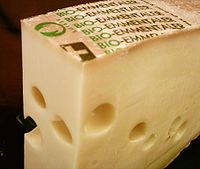Emmental cheese: Difference between revisions
No edit summary |
|||
| Line 29: | Line 29: | ||
In cooking, it is often put on top of [[gratin]]s, or dishes which are put in the oven to let the cheese melt and become golden-brown and crusty. It is also used for [[fondue]], in which case it is mixed with [[Gruyère cheese]]. |
In cooking, it is often put on top of [[gratin]]s, or dishes which are put in the oven to let the cheese melt and become golden-brown and crusty. It is also used for [[fondue]], in which case it is mixed with [[Gruyère cheese]]. |
||
==References in Popular Culture== |
|||
The widely popular cartoon series, Tom and Jerry, features emmental cheese. This is what all the fuss is about. |
|||
==Emmental outside Switzerland== |
==Emmental outside Switzerland== |
||
Revision as of 15:00, 2 May 2013
| Emmentaler | |
|---|---|
 | |
| Country of origin | Switzerland |
| Region, town | Berne, Emmental |
| Source of milk | Cows |
| Pasteurised | Traditionally, no |
| Texture | hard |
| Aging time | 2-14 months depending on variety |
| Certification | No [clarification needed] |
| Named after | Emmental |
Emmental or Emmentaler is a yellow, medium-hard cheese that originated in the area around Emmental, in Switzerland. It is one of the cheeses of Switzerland, and is sometimes known as Swiss cheese. While the denomination "Emmentaler Switzerland" is protected, "Emmentaler" is not; as such, Emmentaler of other origin, especially from France and Bavaria, is widely available and even Finland is an exporter of Emmentaler cheese.
Emmentaler has a savoury, but not very sharp, taste. Three types of bacteria are used in the production of Emmentaler: Streptococcus thermophilus, Lactobacillus, and Propionibacterium freudenreichii. In the late stage of cheese production, P. freudenreichii consumes the lactic acid excreted by the other bacteria, and releases carbon dioxide gas, which slowly forms the bubbles that make holes. Failure to remove CO2 bubbles during production, due to inconsistent pressing, results in the large holes ("eyes") characteristic of this cheese. Historically, the holes were a sign of imperfection, and until modern times, cheese makers would try to avoid them.[1] Emmentaler cheese is used in a variety of dishes, including some types of pizza.[2]
Emmentaler in Switzerland in the 21st century
- Emmentaler Switzerland AOC has been registered since 2000[3] as an appellation d'origine contrôlée (AOC).[4] This “original Emmentaler” has to be aged for a minimum of four months. It is produced in a round shape with a natural rind and aged in traditional cellars. The original Emmentaler exists with different age profiles: classic - four months, reserve - eight months, and Premier Cru - 14 months. It is produced with raw cow's milk, adding only natural ingredients (water, salt, natural starter cultures and rennet). Preservatives or ingredients from genetically modified organisms are not allowed. Emmental AOC is still produced in small rural dairies.
- Emmentaler Switzerland Premier Cru is a special Emmentaler aged for 14 months in humid caves. It was the first cheese from Switzerland to win the title World Champion at the Wisconsin (USA) Cheese World Championships in 2006.[5] It was nominated best cheese among over 1,700 competitors.[6] For this achievement, it has received a place in the Historic Museum in Bern, Switzerland.
In cooking, it is often put on top of gratins, or dishes which are put in the oven to let the cheese melt and become golden-brown and crusty. It is also used for fondue, in which case it is mixed with Gruyère cheese.
References in Popular Culture
The widely popular cartoon series, Tom and Jerry, features emmental cheese. This is what all the fuss is about.
Emmental outside Switzerland
Several varieties of Emmental or Emmentaler have certification, these include:
- Allgäuer Emmentaler, from Bavaria, Germany, has PDO status[7]
- Emmental de Savoie, from Savoie, France, has PGI status[8]
- Emmental français est-central from Franche-Comté, France, also has PGI status[9]
See also
References
- ^ Scientific American Cheese Story August 2010 Pg 33
- ^ "Pizza Menu". http://www.pastamania.com.sg/. Retrieved 18 February 2013.
{{cite web}}: External link in|work= - ^ "AOC-Label für den Käse mit den grössen Löchern". Swiss Info. 13 September 2004. Retrieved 11 December 2009.
- ^ Emmentaler AOC website accessed 11 December 2009. It appears this AOC is not recognized in the EU.
- ^ "Worlds Best Cheese" (PDF) (Press release). Von Mühlenen AG. 24 March 2006. Retrieved 2009-12-11. accessed 11 December 2009
- ^ NICK HEYNEN (March 12, 2008). "CITY HOSTS SUPER BOWL OF CHEESE". Wisconsin State Journal. Retrieved 11 December 2009.. This article mentions 1,941 dairy products, including butters and cheeses.
- ^ EU Profile - Allgäuer Emmentaler (accessed 08/06/2009)
- ^ EU Profile - Savoie Emmental (accessed 08/06/2009)
- ^ EU Profile - Est-Central Emmental (accessed 08/06/2009)
External links
- Emmentaler in the online Culinary Heritage of Switzerland database.
- Cook's Thesaurus: Semi-Firm Cheeses
